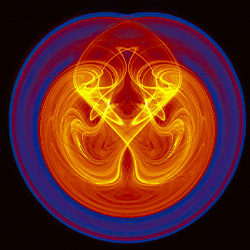Nonautonomous Dynamical Systems: Theory, Methods, and Applications
 This Focus Issue is being published jointly with “Nonautonomous Dynamics in the Climate Sciences.” We encourage authors to submit their papers to whichever Focus Issue best fits their research.
This Focus Issue is being published jointly with “Nonautonomous Dynamics in the Climate Sciences.” We encourage authors to submit their papers to whichever Focus Issue best fits their research.
Nonautonomous dynamical systems have been studied for some time and present unique mathematical challenges because of the lack of invariant sets and other structures that are vital for many analyses of autonomous dynamical systems. Recently, they have attracted wider attention as generalizations of the classical concept of slow passage through bifurcation into more general nonautonomous variation of bifurcation parameters. Noteworthy effects include bifurcation- and noise-induced tipping (B- and N-tipping) and, most strikingly, rate-induced tipping (R-tipping) where thresholds can depend on critical rates and paths rather than merely on critical values. These methods allow one to understand novel effects that appear at the breakdown of timescale separation between a slower forcing and the faster internal timescale of a nonlinear system.
The theory of these critical transitions requires further mathematical developments in the settings of systems of ordinary, partial or delay differential equations, as well as in the methodological and computational implementation of these advances. Several methods have been inspired by applications in the physical, life and earth sciences and are yielding even more impressive results through increased reliance on machine learning and artificial intelligence.
During the last few years tipping phenomena due to parameter drift have attracted increased attention in ecology and the biomedical sciences, as well as in the climate sciences. Recent developments in mathematical methods have led to deeper insights into potential critical transitions in ecosystems as a response to climate change and in the study of time-dependent changes in the development of diseases such as epileptic seizures and prostate cancer. These applications inspired the development of new data-driven approaches to identify critical transitions in nonautonomous systems.
The goal of this Focus Issue is to review recent progress and stimulate further work on potentially applicable theory, methods, and applications of nonautonomous dynamics. The methods considered can include analytical, statistical, machine learning and numerical methods, while the applications may be in any sphere of modelling.
Topics covered include, but are not limited to:
- Nonautonomous, random and stochastic dynamical systems
- Theoretical, numerical, data-drive and laboratory studies
- Applications to the physical, life, earth, biomedical, socio-economic and neurosciences
- Statistical and machine learning approaches and applications
- Mathematics of nonautonomous systems A: pullback and snapshot attractors
- Mathematics of nonautonomous systems B: bifurcation theory, noise and rate-dependent effects, early warning signs
Guest Editors
Peter Ashwin, University of Exeter, UK
Ulrike Feudel, University of Oldenburg, Germany
Michael Ghil, Ecole Normale Supérieure, France, and University of California at Los Angeles, USA
Klaus Lehnertz, University Hospital Bonn, Germany
Juan-Pablo Ortega, Nanyang Technological University, Singapore
Martin Rasmussen, Imperial College London, UK
